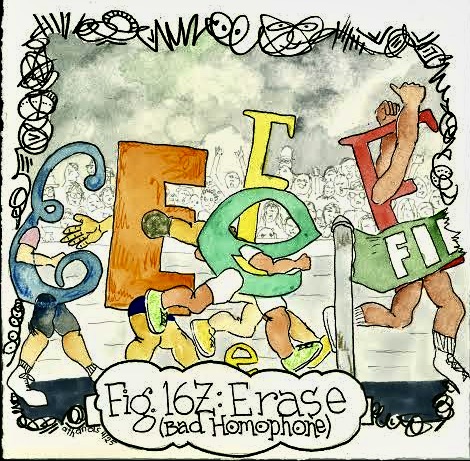Dark-eyed juncos soon to flitter north
Winter meets spring in this image, as a handsome dark-eyed junco perches in a cherry
tree dripping in blossoms.
Dark-eyed juncos are common here throughout our colder months, but the species is moving north for the summer nesting season. They are nicknamed “snowbird” because when they return after September, our first snowfall typically isn’t too long after. Juncos are common in our metroparks in the winter.
Juncos are sparrows that eat seeds, nest on the ground and live in the forests. They are identified by a rounded head, a short, stout bill and fairly long, bright white tail feathers.
This one was photographed in the Oak Openings.
Jefferson Center renovated, renamed

TOLEDO – For nearly a quarter century, the stone building on Jefferson Ave. has remained vacant, until now.
Bitwise Industries, a company dealing with computer programming, was working on turning what was the Jefferson Center, a vocational school for Toledo Public Schools that closed in 2000, into its Toledo campus. But that plan ended when the founders of Bitwise Industries were sentenced to federal prison for wire fraud.
“There are a lot of people that felt once this Bitwise thing collapsed that this building was doomed, and that it would just sit unoccupied and deteriorate,” said Tim Schlatler, managing director of SVN Ascension Commercial Realty, who manages and leases the property for its owner, ProMedica.
“Our role started once the building [renovation] was complete, and our role was to identify and secure tenants for the space,” he said.

After laying low since the Bitwise deal fell through, a ribbon cutting ceremony was held at the end of February with the mayor, Lucas County commissioners and representatives from the first four tenants: Wurtec, WorkSpring, Junior Achievement of Northwest Ohio and SEGULA Technologies USA.
A new name for the building was revealed at the ribbon cutting: The Innovation Post.
“There’s 110,000 square feet of space that’s finished inside the building, of which 77,000 square feet would be occupiable office space,” Schlatler said. “The difference between 110 and 77,000 [square feet] would be restrooms, pantry areas, circulation areas [and] mechanical, so we’d call that the common space.
“Of the space we have available to lease, we have now 65 percent of it leased, so we have 35 percent remaining. That’s what we continue to work on, to fill the remaining space,” he noted.

Securing those first four tenants were necessary to meet the operational cost of the building, and since the announcement more companies have signed on, excited to see what’s next for Toledo.
“We had these conversations, and said to them [the first four] as a group, ‘If all of you commit, we can get this done,’” said Schlatler.
Schlatler’s own company, SVN, will be moving into the Innovation Post, along with Presidio (an IT company), Mud Maintenance (the janitorial staffing company for the Innovation Post and other properties), ProMedica’s IT training division, ProMedica’s security training division and groundUp Creative Agency (a marketing company).
“Business cards have been traded,” said Blake Pilgrim, president of Wurtec, the company taking up the entire third floor, which is the largest amount of space in the Innovation Post. “It’s important for us to be a part of a community that drives innovation, and it’s equally important to see Toledo prosper.”

“It’s the start of a new community, really. This innovative community is coming together under one roof to cross-pollinate,” Pilgram added.
The large atrium of the Innovation Post is marked by a downstairs cafe, a large stairwell with sitting areas along its side and glass walls, fostering a sense of community across the three floors.
“There’s no doubt that some of our engineers will be talking with other engineers [from another company], and they’ll be like, ‘Oh, wow, you guys invested in this software, you know; we should look at that,’” Pilgrim said, about his hope for building community innovation.
Pilgrim thanked SVN and Brandon Sehlhorst, the commissioner of economic development for the City of Toledo, for vision casting what the area around the Innovation Post may begin to look like with the development of these companies downtown.
“We’re bringing 60 to 70 high paying, office positions into that area of our community, and their ability to spend money, whether it be on restaurants or shopping or those sort of things I think, drives other people to continue to invest in that portion of our community,” Pilgrim said.
Wurtec and WorkSpring are preparing to move into the new space May 1.
“The first install is Wurtec,” said John McNerney, owner of McNerney and Sons, who oversees the installation of the office space.
“Each business has their own look and feel of how they want it,” he said, as workers secured workstations on the third floor of the Innovation Post.
Schlatler provided the following diagrams of the Innovation Post, illustrating available areas for rent that range from $375 to $3,925 per month.
Learn more about the property here.




Literature, caffeine: The perfect blend

Christian-based bookstore open to everyone
BOWLING GREEN – Coffee is indispensable for many, and it is especially so for college students, like those at Bowling Green State University. Coffee and reading…what could be a better fit for a college town?
Novel Blends, a local shop, has hit on the perfect niche.

In an average coffee shop, there’s the counter to order and a handful of tables and chairs, but not much else. But upon entering this store, there are books lining the walls on both sides, and heading back there are more places to sit. It feels like stepping into a library, where the possibilities for reading are endless.
April Hickman, a frequent customer at Novel Blends, said she loves it here “because it’s beautiful, I really like the rustic feel.”
Many coffee shops aren’t looking to keep people staying around longer than their last sip, and that is what manager Sean Stoepler believes sets Novel Blends apart from the rest.
Stoepler said, “We have a homey vibe, and we don’t want anybody to feel uncomfortable here.” Along with the bookshelves in the store, there are several comfortable chairs and even a few couches spread around.
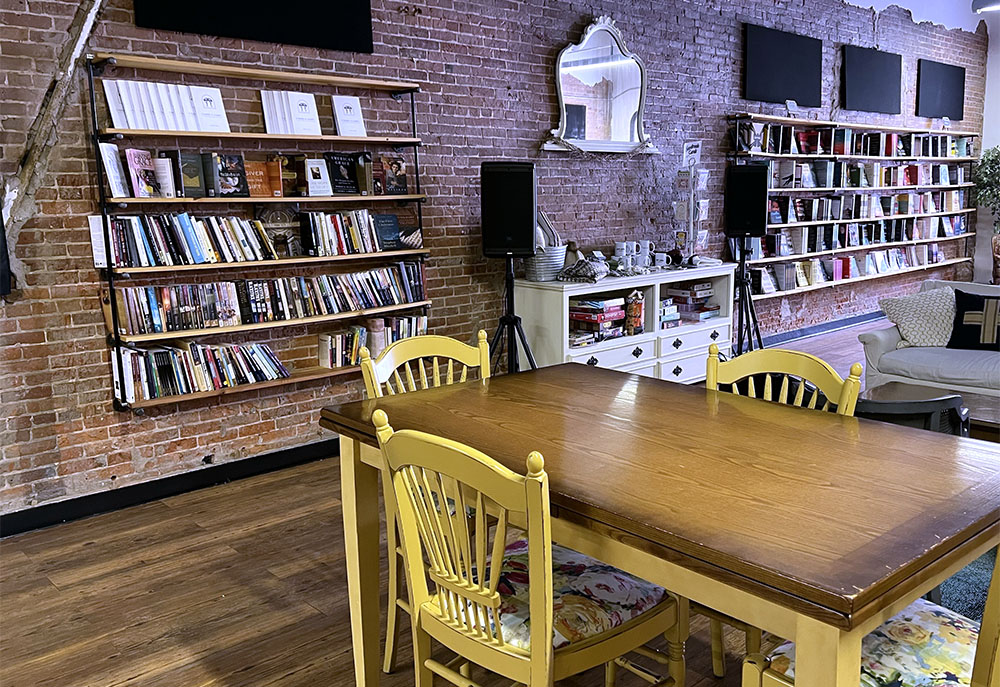
Stoepler also spoke about the history of the shop. Business has been growing slowly, but they are busy, with customers coming in consistently. “It opened in 2021, and we’ve been steadily growing since – up 20-30 percent since we opened.”
The idea for Novel Blends was spawned by Stoepler’s father, Michael Stoepler, who wanted a place for his children to go. He wanted the spot to appeal to all sorts of people, including Christians.
“He wanted a shop that could act as a safe place for Christians to go and feel comfortable, and of course we’re welcoming to everybody,” Sean explained.
The owners of the shop are Christians, and they wanted their shop to fit that vibe for others who share their beliefs. There are some religious books stocked on the shelves, and Bible study groups love to meet in Novel Blends. Visitors will even hear contemporary Christian music piping through the speakers.
“We’re Christians and I really like how this place makes me feel welcome. I also think it’s good that they’re inclusive of everybody, not just Christians,” Hickman said. Novel Blends extends their hands to everybody who comes in.

Novel Blends carry a large variety of books, from faith-based nonfiction to popular bestselling fiction. The large sitting area is very inviting and encourages people to relax. The guitar and art on the wall attract people to the shop.
Students come to study, bringing their laptops and drinking coffee. Many other people come to find a good book from the shelves and read to unwind from the stressors of life. Some parents like to bring their kids, and some people like to go on their own.
Novel Blends hosts a variety of events, as well. Those events include, but are not limited, to Bible studies, book clubs and counseling groups. You can follow them on Instagram for more information on upcoming events and new menu items.
UT held Q&A to address fear of SEVIS record terminations
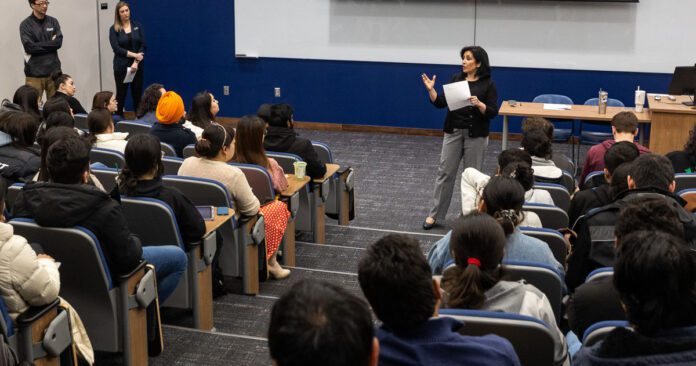
TOLEDO – Anxiety and uncertainty marked an impromptu Q&A held by the Office of International Student and Scholar Services (OISSS) on the campus of the University of Toledo last Thursday, April 10.
About 200 students attended the event, originally meant to be held in the Snyder Memorial Building, but student demand forced the university administration to switch the location of the Q&A at the last minute to a larger room in the Health & Human Services building.
Addressing a room of nervous students, Sammy J. Spann, Ph.D., senior associate vice president and dean of students for the University of Toledo, opened up the session with reassurances, saying among other affirmations, “You are not alone,” before handing over the session to the OISSS department.
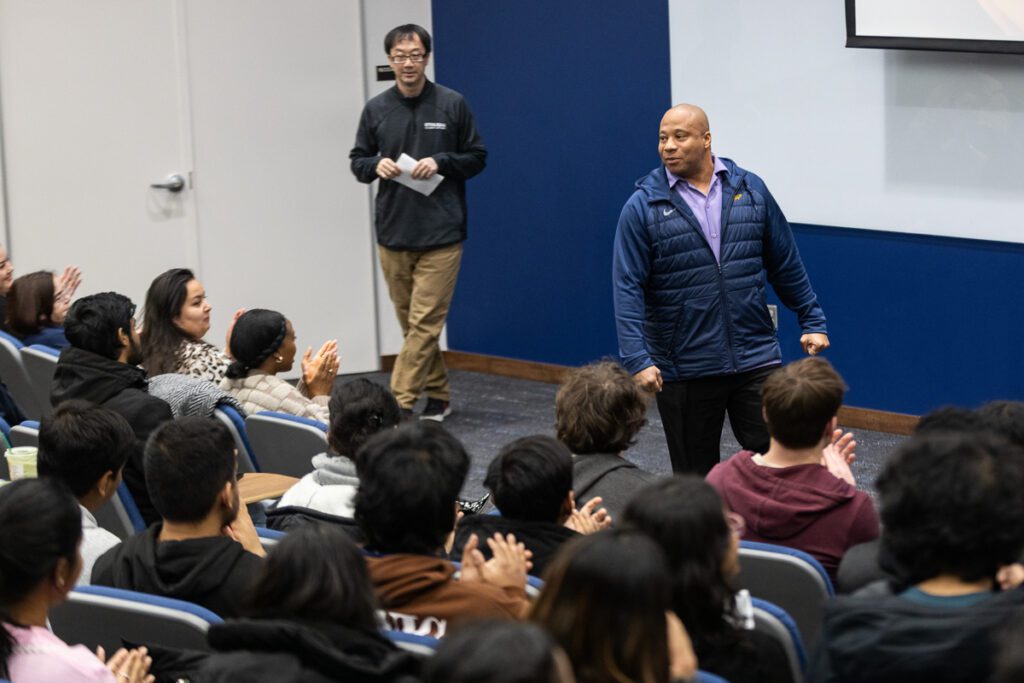
According to Spann, the Q&A was a direct request from the student body, a reaction to the handful of students who had their Student and Exchange Visitor Information System (SEVIS) record terminated.
SEVIS is the online record and status that allows nonimmigrant students to apply for and hold F-1 or M-1 Visas to study academically or vocationally inside the United States.
University of Toledo employees admitted that having a student’s SEVIS canceled in the middle of a semester was abnormal.
“I never used to check our SEVIS records,” said Jessica Bergman, manager of immigration compliance for UT, and added, “But we are checking them now; refreshing it everyday, many times a day.”
Bergman and Maryam Sediqe, J.D., the assistant director of the Center for International Studies and Programs at the UT, led most of the Q&A, and opened up the discussion by explaining that there are “many reasons why the government might terminate a [SEVIS] record.”
The two women said that, unfortunately, even under normal circumstances, the University would not be privy to the specifics about why a SEVIS record might be terminated. “Sometimes they give you a reason, but it’s not a specific reason,” Bergman said.
She added, “We’re not hearing anything from the government,” and told the students that the university was in contact with other institutions to cross-reference their information in hopes of deciphering any patterns.
In the face of so much uncertainty, OISSS recommended their students err on the side of caution until more information becomes available.
“I know students make mistakes,” Bergman said to the crowd. “But we don’t know how or why they picked [these students].”
Bergman and Sediqe cautioned the students to keep their records clean, even to avoid traffic violations; to be aware of what they post on social media; to avoid making waves that might be used against the students in any way; and for the students to avoid traveling right now.
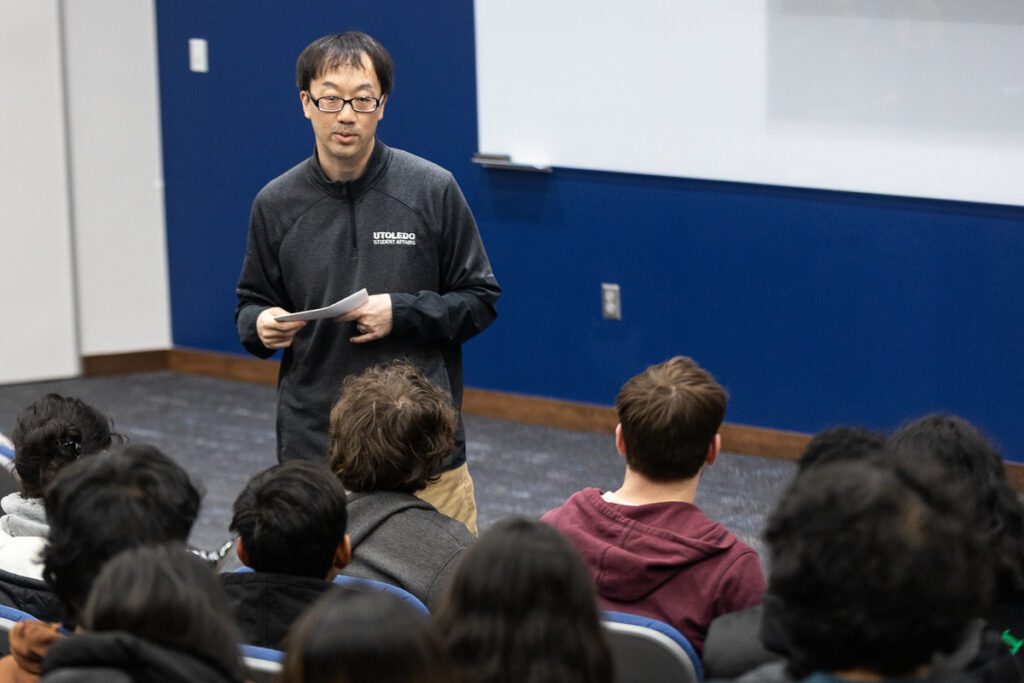
Spann confirmed that Immigration and Customs Enforcement (ICE) officers had not been seen on campus as of the meeting.
“We have chaos all the time,” Spann said. “We’re learning how to navigate through this chaos.” And he reminded students that “the history of America has been way worse.”
Bergman and Sediqe told students if their SEVIS record was terminated, they would be contacted through the email the student used to apply for their current visa.
OISSS recommended all students familiarize themselves with immigration attorneys in the area, and said that the university had their own immigration attorneys to help students as long as they held status.
No students wished to share any information with the Toledo Free Press, but one student asked during the Q&A if the university would cover the costs of an immigration attorney or provide one to students if their SEVIS record was terminated. Bergman answered that the university would not provide an attorney in this circumstance, but that the university would recommend immigration attorneys to the students if their SEVIS record was terminated.
Sediqe told the students to carry all their travel documents with them, including their passport, visa and I-94, etc., or at the very least to carry copies of important documents in case an individual from ICE did stop them.
To verify to the officer, in the event that a student was stopped, Sediqe told students to ask for the officer’s badge, and said, “People can impersonate officers, and they have to show you their badge.”
She told students that their documents would have to be turned over to ICE for inspection if requested, but that ICE officers needed a warrant to search any place or items.
A delineation was made between the public parts of the university, where ICE would have access without needing a warrant, and private parts of the university, like classrooms and dormitories, where ICE officials would need a warrant signed by a judge.
Even with all the information, students were visibly uneasy, and a young woman expressed that fear during the Q&A.
“I’m trying to have all my bases covered, even though I haven’t done anything wrong,” she said.
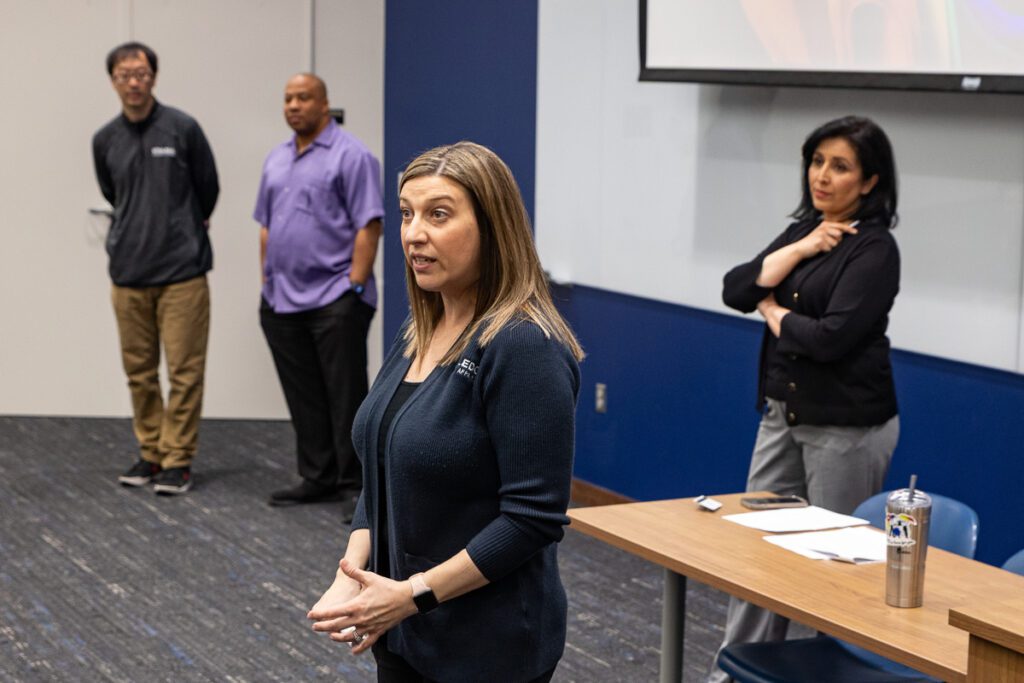
OISSS tried to reassure the students, saying they had the backing of the provost to do everything in their power to keep the students in the country, and if staying in the United States was not possible, the university would try to help the students finish their degree, regardless of what country they were in.
When answering student’s questions, Bergman said the university had been able to cover the cost of a plane ticket back country of origin for one of the students who had their SEVIS records terminated. Bergman could not guarantee this type of help to all students, and said that the university would evaluate what they could do for students on a case-by-case basis.
“Maintaining your status…that’s the most important thing right now,” Sediqe said, and recommended students be prudent and continue attending classes to finish out the semester.
“There’s nothing special, except to carry all your documents with you, and maintain your status,” she said.
Navigating a refugee resettlement in Toledo
What one family and nonprofits are experiencing in 2025
TOLEDO – After fleeing Syria and its civil war, Mrs. Alnimer was ready to be reunited with her daughter, Diana Altheyab, in Toledo.
“When they opened the Welcome Corps program I directly applied for my family,” Altheyab said about the finishing touches on the refugee resettlement process she initiated. She expected her mother, sister and brother to arrive in Toledo very soon. “I received the schedule.”
Through a 2023 State Department program called Welcome Corps, five or more U.S. citizens could work with the government to sponsor refugees to be resettled in communities across the United States. Beginning in early 2024, Altheyab organized a number of her fellow U.S. citizens to take the place of a traditional refugee resettlement agency.
“It’s private citizens getting to choose their next neighbors and saying, ‘We want this and we’re willing to flip the bill for the federal government to be able to welcome refugees,’” explained Annie Nolte-Henning, executive director of Community Sponsorship Hub (CSH), a national nonprofit coordinating private sponsorship and traditional refugee resettlement across the United States.
Refugee resettlement, whether private or through an agency, lasts 90 days and involves “ensuring people have housing, getting kids enrolled in school, helping mom and dad find a job,” Nolte-Henning said.
Seven refugees, including three immediate family members and their families, were part of the process started by Altheyab, who raised the money to get her family to safety at the price of $2,375 per refugee, the price as of fiscal year 2023.
Preparations were made for the move to Toledo, including housing and furnishings. And on the refugees’ side, Altheyab’s family began to sell off their belongings in Jordan, where they have been staying as refugees for over a decade.
But what was supposed to be wind in the sails for Altheyab ended up deflating her hope.
“They sent me an email to confirm the money,” she said about the United States Citizenship and Immigration Services (USCIS). And there was one last Zoom call “to confirm that I want them [her family] to come here or not.
“I scheduled [their trip] on the 23rd (of January), then they, they cancel[ed] it the same day,” she lamented. “It was such a shock for me.”
Closed borders
“Overnight and without notice, the entire humanitarian infrastructure that supports newly arrived refugees in the U.S. was dismantled,” said Nolte-Henning. “It was a shock to the system. We were all bracing for something. It just … a stop work order was not what we were bracing for.”
Six executive orders came down from the office of the president on January 20, on President Donald J. Trump’s first day of his second term, locking down the borders of the United States for at least 90 days. Refugee resettlement agencies were ordered to stop their work and roll back provisions and protections for immigrants.
Originally, on the executive orders themselves, these changes were set to take effect on Jan. 27, so Altheyab had moved quickly to get those seven people on a plane to the U.S. before the borders closed.
But without warning, the effective date of the executive orders was moved up to the 23rd.
“My group there in Jordan, they finished everything,” Altheyab said about the long process her family went through to legally and successfully be approved to immigrate to the United States as refugees. The only thing left after the Zoom orientation was booking the flight.
Her mother, brothers and sister were approved as refugees by the United Nations High Commissioner for Refugees (UNHCR), then screened by the U.S. Department of Health and Human Services (HHS), screened by the U.S. Department of Homeland Security (DHS), and then coordinated travel with the State Department, USCIS.
Altheyab said she was so despondent about not being reunited with her family that she spent two days sick in bed. “I was frustrated by this.”
The scramble
The abrupt nature of Trump’s executive orders transitively cut out most traditional refugee resettlement infrastructure by eliminating what the resettlement nonprofits do.
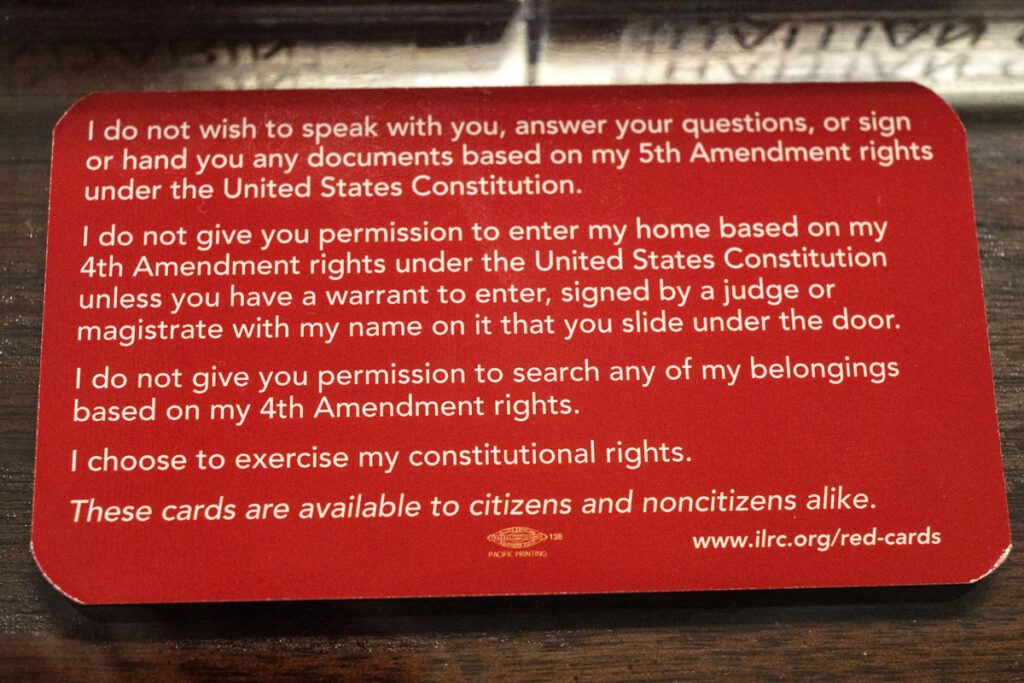
“I lost 85 percent of my workforce,” Nolte-Henning said about her organization, which, in the past, received money from the federal government to resettle individuals.
“The stop work order essentially means that you can’t implement the work, and you cannot charge against your grant to do the work,” so layoffs were the next step.
And then, after downsizing, Nolte-Henning pivoted her organization to help refugees inside the U.S. who had been dropped by their resettlement agencies, and to help Afghans overseas who have Special Immigrant Visas, a program that has not been halted by the Trump administration, yet.
“It’s not just about admissions being suspended, but it has also cut off vital services to refugees who have already lawfully arrived in the U.S,” said Nolte-Henning.
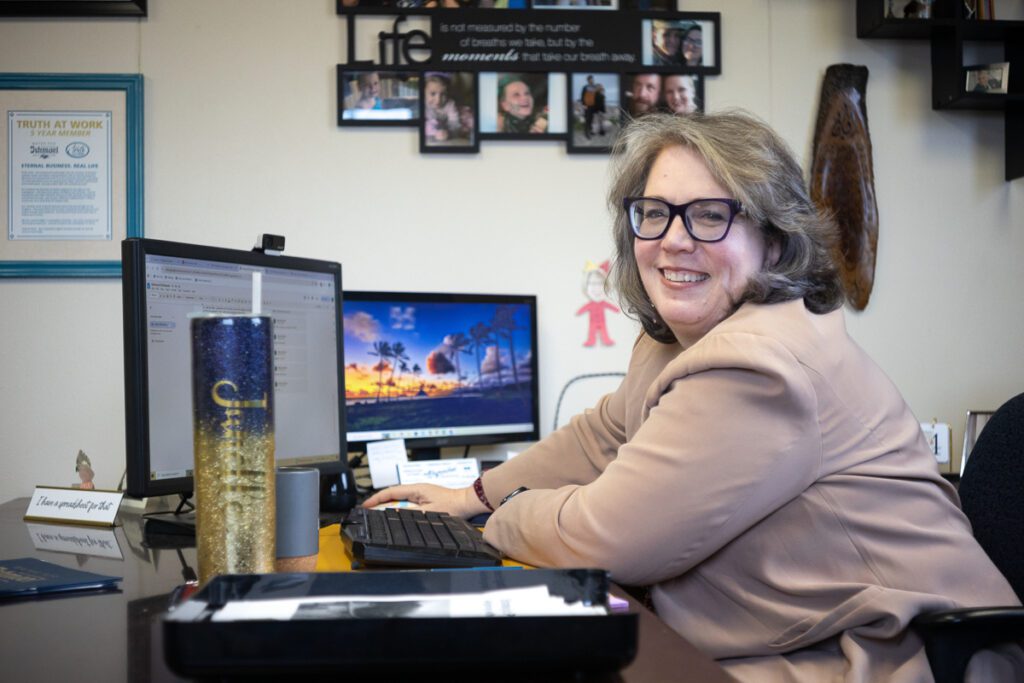
A federal judge attempted to block the complete halt of refugee admissions. The judge said halting all refugee admissions would cause, ”irreparable harms, including refugees stranded after selling their possessions, agencies laying off hundreds of staff, and family reunifications suspended indefinitely.”
Thousands of refugees who came to the U.S. before late January were left without the guidance they would have traditionally received from resettlement agencies.
“So we’re prepared to take on local cases, if needed, of people that are left without case workers or without services that they need,” said Janelle Metzger, executive director and founder of Water For Ishmael (WFI), an English as a Second Language nonprofit (ESL).
Altheyab’s journey: The siege of Homs
Altheyab’s own journey to the United States took four years since she was forced from her home in Homs, Syria.
Luckily, she and her immediate family made it to Toledo in 2016, right before the so-called “Muslim ban.” Before coming state-side, Altheyab lived in Jordan for two and half years, and spent the other one-and-a-half years looking for somewhere safe inside Syria.
Homs was heavily bombed, forcing her and her husband to flee with their children, all five-years-old or younger. Hezbollah, Russia and the Syrian Social Nationalist Party, a fascist relic leftover from World War II, all had documented war activity near Homs.
“I have three baby kids, and we were so young, we were scared, and we had no home,” Altheyab said, recalling the tumultuous time. “We were scared from the killing,” she said, as she told of stories of soldiers forced to kill family members to prove their loyalty to Assad.
Eventually, the violence became unavoidable and began to unfold around the family as resources became scarce.
“So, this car came from Damascus … to sell these groceries,” she said as she began to explain that violence started to break out around the limited commodities of food.
“That’s the day we decided, yes, we have to flee to Jordan, because we had three babies. I had, like five and three and two months [old].”
Refugee living
Under the protection of the United Nations, the couple and their children tried to make the most of a time with little forward progress in sight as they navigated life as refugees in Jordan.
Altheyab did her best to educate her children on her own, providing for them with food while her husband looked for work.
But work was not readily available for Syrians living in Jordan, and Altheyab’s husband was forced to work for rebated wages, with no work protections and no guarantee he would be paid at the end of his work.
“If you are [a] refugee there [in Jordan], you feel like people look [at] you, always, like you are a refugee,” Altheyab said. “As a refugee, you cannot work as you want, you cannot study as you want. People look [at] you, especially in Jordan and Syria.”
“We are a similar culture and similar language, but we also have discrimination,” she said.
The United Nations offered Altheyab an opportunity to go to America, and she accepted. Two and a half years later, after extensive screenings by the UN and the USA, Altheyab, her husband and her three children were able to make it to Northwest Ohio.
Shifting sands: refugee policy in the U.S.
“To be here in America, to be honest, it’s very safe and we have our rights,” Altheyab said. “We feel we are human here, so we decided to come here.”
Soon after Altheyab and her family arrived in the United States, Trump instituted the executive order that halted travel from many Middle Eastern countries, and he specifically barred Syrian refugee resettlement to the United States, blocking the rest of Altheyab’s family from coming in 2017.
Presidents set the number of refugees allowed to enter the United States in a given year, known as the Refugee Ceiling.
The Refugee Ceiling for 2017 was initially set by President Barack Obama at 110,000 refugees, but was cut by over half, down to 50,000 total refugees allowed to enter the United States that year by Trump, the new president.
Over the four years of the first Trump administration, the Refugee Ceiling lowered down to the lowest Refugee Ceiling in United States history, at 15,000 refugees allowed to be resettled for 2021.
When Joe Biden got into office, he responded by hiking the Refugee Ceiling up to 62,500, in May of 2021. But the four years of the Trump administration had already damaged the nonprofit infrastructure responsible for doing the work of resettling refugees.
“We were really undermined, and then you know, it declined from there with our all-time-low under Trump,” said Angela Plummer, executive director of Community Refugee & Immigration Services (CRIS), when asked about how the first Trump administration had affected her organization during that time.
CRIS is a traditional refugee resettlement agency that helps refugees secure housing, find jobs, enroll in school and integrate into the social areas where the refugees have been relocated.
Of the 900 refugees CRIS was set to resettle in 2017, after the changes from the Trump administration, only 300 were able to make it to the United States that year, and their numbers declined each year as the Trump administration continued to lower the Refugee Ceiling.
And even though Biden raised the Refugee Ceiling to 125,000 in 2022, only 25,000 refugees were resettled in the U.S. that year because the resettlement agencies were not able to build back as quickly as they had been cut.
“You can’t just stop and start people,” Plummer said, adding that people stopped years ago had built their lives elsewhere.
The government gives CRIS $1,273 per refugee to spend on that refugee’s behalf, and help them resettle within the first 90 days of the refugees’ time inside the United States.
“It’s not like this is just a government-funded program. It doesn’t work; I mean, we have to find other funds to make sure people can pay all of their rents, especially as I noted, since the per capita amount [the amount of funding per refugee] hasn’t been going up for some time,” Plummer said. “And that $1,273 amount is for all 90 days.”
Plummer said that “it really impacts having an economy of scale. I mean, you can run a much more efficient program at a certain level,” with a certain number of people.
Efficiency and ease of process were not priorities for the Trump administration.
“They threw in new bureaucratic requirements that, in my opinion, did nothing but bog down the system,” Plummer said.
“Instead of refugees having to provide five years worth of addresses, now they wanted 10 years, [and there were] new forms being required…so it’s just putting all kinds of people who had already been screened through the system, like back into a pile of needing to go through security clearances, and things ground to a halt.
“After you had the very overt, ‘we’re not going to allow these people from these countries to come,’ then you had all this stuff behind the scenes, that was kind of the bureaucratic method of stalling.”
Luck of the draw
Just before the refugee system began to get bogged down, Altheyab got in with her immediate family, but the rest of her extended family (mother, father, sister brother) were not so lucky.
An already overburdened and actively undermined system did make room for 6 million displaced Syrian refugees, and effectively stopped Altheyab’s family from uniting with her on U.S. soil.
Biden, in reaction to the rising worldwide refugee population, revitalized a private sponsorship model for resettlement, first with a prototype for Afghans, called Sponsor Circle, then for Ukrainians with the 4UA program, and finally to all formal refugees through the Welcome Corps program in 2023.
Through private sponsorship and Welcome Corps, American citizens were able to partner with the State Department to bring refugees to the United States with private funding.
“So when they opened the Welcome Corps program I directly applied for my family,” Altheyab said.
This was the first time in nearly ten years Altheyab had an opportunity to actively participate in the process of bringing her family to America.
Even though Welcome Corps launched in early 2023, the organization Altheyab went through, Water For Ishmael only got their certification as a Private Sponsor Organization in the first quarter of 2024, and then a year later the program was shut down.
But then, on Trump’s very first day in office, the president put a halt on all new refugee resettlement, and Altheyab’s dreams of reunification were disrupted.
No longer welcome
“We can’t call anything we do Welcome Corps right now, because we did get a cease and desist order from Washington,” said Metzger, who was integral in pushing her organization to receive the Private Sponsorship Organization certification.
“Right now, the federal government isn’t guaranteeing [that] any refugee who’s already here [in the United States] gets provided the services that they need,” said Scott Andrews, formerly the director of the Private Sponsor Groups, who oversaw the groups of five or more resettling refugees.

Since the interview with Andrews, the Welcome Corps program has been completely dismantled and Andrews works as the director of operations for WFI now.
“The message was simply, ‘You need to stop all work that you’re doing right now,’” said Andrews.
“You can imagine if you just arrived a few days ago as a refugee, you don’t speak the language and you just found out that the accommodation you were promised is gone. You have no place to stay; you have no source of income; you have no job; and you’re just supposed to wander the streets? This is not good for our communities,” Andrews said.
“If this is a money thing [where federal grants are lost], we can sort that out,” Andrews said, but he was unsure if the federal government would forcefully try to stop the organization from helping refugees already in the United States because of the ambiguity of the communications.
Hold please
Even though all refugee resettlement initiatives have been paused with the exception of Special Immigrant Visa holders, technically not refugees, Altheyab holds out hope for her family.
One of the executive orders details that Trump will reconsider allowing refugees into the United States after 90 days from the executive order, April 20, and that is where Altheyab’s hope lies.
After the 90 days, the Secretary of Homeland Security and the Secretary of State will submit a report on “…whether resumption of entry of refugees into the United States under the USRAP (United States Refugee Admissions Program) would be in the interests of the United States…”

“I hope this action can change before the 90 days,” Altheyab said. “Because my family…they sell everything,” in anticipation of leaving Jordan.
“I sent something to Marcy Kaptur [the U.S. Representative from Ohio’s 9th district]. I send every day,” she said about asking for help in getting the rest of her family into the United States.
Altheyab’s mother, brother and sister have been waiting in Jordan for the hostilities to subside in Syria since 2012, and the recent takeover of Syria by Hay’at Tahrir al-Sham (HTS) has not brought a peaceful conclusion to the war.
Revenge killings, massacres of civilians and ethnic cleansing have already been a hallmark of the HTS takeover, and it is unclear if Syria will stabilize its political situation anytime soon.
And it’s anticipated that, at the very least, Trump will significantly decrease refugee admissions.
“I hope Mr. Trump [will] change his mind about bringing refugees, especially Welcome Corps, because it’s our own money, it’s our responsibility, so we decided to bring these people, we know these people. It’s our family,” Altheyab said.
Goaldiggers: Miracle on Main Street

TOLEDO – A majority of sports fans of a certain age are familiar with the U.S. hockey team’s “Miracle on Ice” at the 1980 Olympics in Lake Placid, N.Y. And they probably remember New York’s “Miracle Mets,” who came out of nowhere to beat the Baltimore Orioles to win the 1969 World Series.
Barry Manilow’s smash hit, “It’s a Miracle,” debuted in 1974. That same year, an expansion hockey team from Toledo would complete what local hockey fans thought was a million-to-one shot at the end of the 1974-75 season – win the Turner Cup championship trophy.
That season – particularly the Goaldiggers’ surprising playoff run – has been fondly referred to as “The Miracle on Main Street” ever since.
Eleven players and family members from the 1974-75 team returned to downtown Toledo on April 13 for a meet-and-greet at Imagination Station, celebrating the 50-year anniversary of the Miracle on Main Street. Fans got signed autographs from the players and took photos with the Turner Cup, which was on loan from the Hockey Hall of Fame in Toronto.
The Goaldiggers were young and led by a fiery Canadian-born coach named Ted Garvin, who coached the Detroit Red Wings a year earlier, only to get fired 11 games into the season. The Goaldiggers sloshed through the 1974-75 regular season, finishing with a 34-38-4 record and a third-place finish in the 11-team International Hockey League’s South Division.
John Martin, then a 6-foot, 200-pound left wing, was moved to defenseman by Garvin 15 games into that season. Martin played college hockey at Providence College.
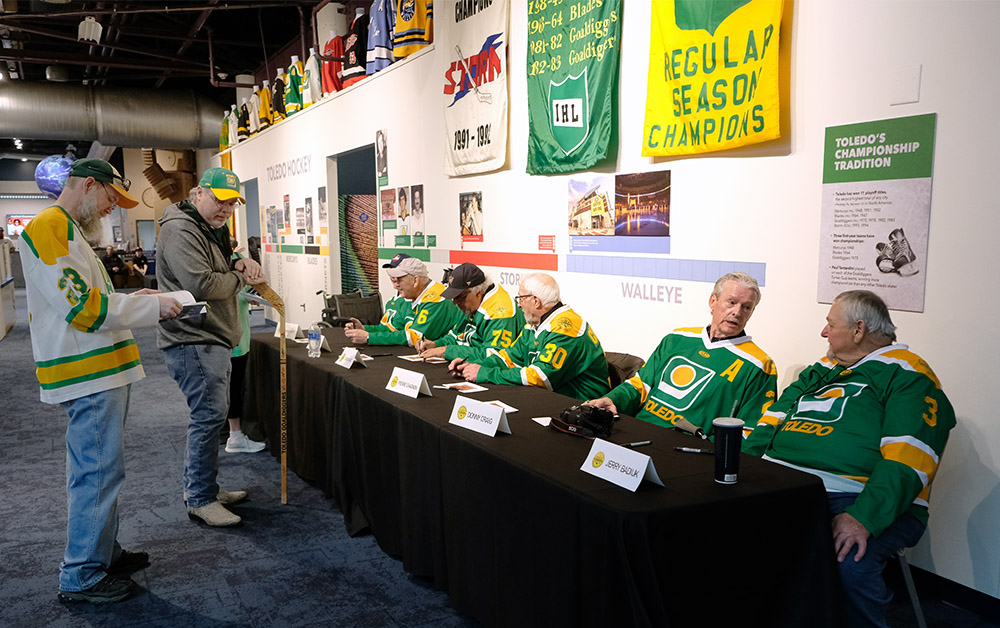

“I grew up playing forward,” said Martin, 75. “Defense was not my best position. I loved it here in Toledo. The players, the fans…the reception we got was outstanding. The fans were unbelievable that year, their passion with hockey and towards us.”
Martin has fond memories of the Goaldiggers playing their home games at the old Sports Arena, located on Main Street in East Toledo. The Sports Arena was demolished in 2007.
“When I was at Providence we played at the Rhode Island Auditorium, which was similar to the Sports Arena,” Martin said. “Our fans were very friendly to us, but not to the other team. We gave everything we had and those fans gave us everything they had.”
One of those fans was Don Kier, 71, who attended the meet and greet at Imagination Station. He was a die-hard Goaldiggers fan back in the day. Kier was studying journalism at the University of Toledo when the Goaldiggers won the Cup in 1975. He still has a photo of the Goaldiggers’ players raising the trophy after winning the Cup in 1978.
“We would go downtown to the hockey games and sit in section 104, behind Eddie Rutherford, the organist,” said Kier, who is also a huge Toledo Walleye fan. “We finished towards the bottom of the division [in ‘75] and came out of nowhere to win the Cup“We had two very good goalies in Ted Tucker and Pierre Chagnon. Tucker was in net in game 7 [of the Cup finals], and it was his birthday. Ted Garvin knew how to motivate the team and how to motivate the fans. He was a coach and showman in one.”

The Goaldiggers beat the Columbus Owls in five games in the first round of the playoffs to set up a best-of-seven semifinal series with the South Division champion Dayton Gems.
Toledo inexplicably won that series in six games to advance to the Cup finals against the Saginaw Gears, who had the home-ice advantage in the series.
“Ted came up with another system for the playoffs,” Martin said. “We went more defense – one player was on the offensive end and two players stayed back. It was a different style. NHL teams used that, but these (playoff) teams never saw us do that.
“When Ted coached us, he coached us to get us into the playoffs,” Martin added. “We were a first-year team, so he wanted us to get in the playoffs and win it.”
Doug Mahood was a 5-11, 220-pound right wing for the Goaldiggers. He was raised in the tiny town of Teeswater, Ontario, Canada, and played for Toledo for two seasons before getting traded to Port Huron in 1977.
Mahood was a member of the Goaldiggers’ infamous “Murder Inc.” line in 1974-75. Mahood, at right wing, Willie Trognitz at left wing and the late Paul Tantardini at center formed a formidable trio.

“We were tough,” Mahood said. “I was tough and good in the corners, winning battles. I was intimidating, a good checker.”
Mahood said he never had an issue with Garvin’s coaching style. Garvin passed away in 1992 at age 69.
“He was phenomenal,” Mahood said. “He knew when to pat you on the back or kick you in the butt, and he never held a grudge. You knew where you stood.”
The Saginaw Gears finished third in the IHL’s North Division in 1974-75. They were a third-year franchise coming off a surprise run to the Turner Cup finals the previous season.

In essence, the ‘75 Turner Cup finals featured two third-place teams that got hot when it mattered. The Gears went 43-29-3 during the regular season and had an advantage in the fact that if the finals went to seven games, Game 7 would be played in Saginaw.
It was.
Toledo won Game 6, 7-3, to set up the championship game. On May 7, 1975, the Goaldiggers beat the Gears, 6-5, on center Juri Kudrasovs’ eventual game-winning goal with 4:45 left in the third period. Ironically, Kudrasovs, a native of Brampton, Ontario, played for the Gears the previous two seasons.
Former Toledo sportscaster Jim Mengel, who covered the Goaldiggers and worked weekends for Toledo Channel 13, was at Game 7 and watched Kudrasovs’ shot hit the back of the net.
“When they started the season, they were rough,” Mengel recalled. “Then Garvin paid more attention to winning games. Toledo fans weren’t there just for fights. I don’t like to predict, but I knew it was going to be tough.”
Mengel shared what went through his mind when Toledo scored with 4:45 left against the Gears. “I was rooting for the Goaldiggers. I thought, ‘This is going to be the longest four minutes and 45 seconds in existence.’ ”

Toledo held on when a Saginaw shot bounced off the Goaldiggers’ goal post with five seconds left in the game.
An estimated 10,000 Goaldiggers fans took to the streets downtown to celebrate that night, surrounding the Sports Arena as Tiedtke’s department store literally went up in flames, two years after it closed.
The players were thrilled with the fans’ turnout. To quote the lyrics from Manilow’s hit 1974 song: And, baby, there’ll be dancin’ in the street.
“I was 22 and our team doctor told me to savor every minute, and that I would remember this my whole life,” Mahood said. “Other than getting married and having children, that was the most special time of my life.”
Mahood retired from hockey following the 1977 season and has lived in Toledo ever since.
“Toledo,” he said. “has always been good to me.”
ANNOUNCEMENT: The HOCKEY: Faster Than Ever exhibition is officially extended through August 31 at Imagination Station. HOCKEY: Faster than Ever is a traveling exhibition produced and toured internationally by Flying Fish in collaboration with the Montréal Science Centre and supported by the NHL and NHLPA.



